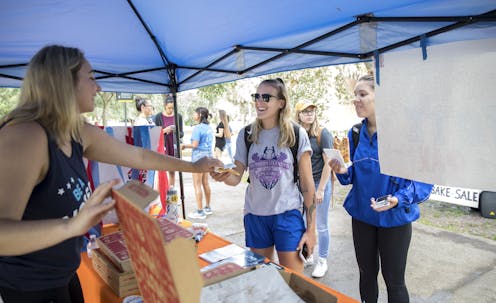
NextGen, a youth and democracy group, encouraging University of Central Florida students to vote early on campus in the 2018 midterms, Orlando, Florida, Oct. 25, 2018. Willie J. Allen Jr./AP Images
Republican-led legislatures in several U.S. states, from Indiana to Oklahoma, are considering imposing restrictions on early voting, from shortening the number of days to tightening ID requirements for voters.
Florida, by contrast, offers several tools to increase voting access, including for young people – a historically low-turnout group. Floridians may preregister to vote at age 16 and request vote-by-mail ballots with no justification needed. And starting in 2018, Florida election officials began offering in-person early-voting sites on college and university campuses after a federal judge nullified a 2014 rule barring higher education facilities from serving as early-voting sites.
I am a lecturer of political science who studies American political development and public law, and my research suggests that expanding on-campus early-voting sites can boost turnout in U.S. elections by making voting more convenient – not only for students but for residents of surrounding communities too.
Campus voting is popular
I have been tracking votes cast at on-campus early-voting sites in Florida since 2018. The data shows these voting sites are increasingly popular.
My research shows that 59,205 votes were cast across 12 Florida campuses hosting early-voting sites in 2018. That number increased to 92,344 at 11 locations in 2020 and jumped again – by about 50,000 votes – during the 2024 election.
During 14 days of early voting in October and November 2024, 142,085 Floridians cast ballots across 16 on-campus early-voting sites across the state. One-quarter of them – 35,245 voters – took advantage of three campus sites in Miami-Dade County, the state’s most populous county.
A 2019 study by the Andrew Goodman Foundation, a nonprofit promoting youth participation in democracy, determined that overall voter turnout in Florida increased during the 2018 election, in comparison with previous midterm elections, in part “due to the added convenience” of on-campus voting.
Greater access to in-person early voting also increases the likelihood of a person’s ballot counting, since mail-in ballots tend to be rejected at higher rates than in-person votes.
Who votes on campus?
On-campus early voting makes elections more accessible for all voters.
My data from 2024 shows that 35% of voters at Florida’s 16 on-campus early-voting sites were registered Democrats and 32% were registered Republicans. The remaining 33% registered with minor parties or had no party affiliation.
These results differ from voter registration data from 2024 in Florida, which shows 40% of registered voters as Republicans, 31% as Democrats and 29% as other. That is to be expected, because studies of on-campus early voters in Florida find that these voters are younger and more diverse than those at other polling places.
Both students and local residents may vote at on-campus polling sites in Florida.
A 2019 report from the Andrew Goodman Foundation found “Hispanic and Black voters disproportionately cast ballots” at campus locations alongside college-age voters. It also said that 56% of early voters at campus sites were under age 30.
Differences in party turnout at tracked sites, then, may reflect the higher share of Gen Z voters registered as Democrats or with no party affiliation.
Obstacles to voting access
Before casting a ballot, voters face four decisions. First, whether to register to vote. Second, whether to vote in an election. Third, how to vote: early in-person, vote-by-mail or on Election Day. Fourth, whom or what to vote for.
Turnout rates among young voters vary widely across states, but in states where on-campus voting locations are frequent – such as Arizona, Florida and North Carolina – youth turnout tends to be higher.
In the 2024 election, people ages 18 to 29 represented 14% of overall Florida voters – roughly on par with their proportion of the state’s population. It is difficult to make a direct comparison between the voting age population and voter turnout rates because of voter eligibility rules.
But, for reference, 18-to-29-year-olds made up 14% of voters in Texas in 2024, too – yet are estimated to be nearly 17% of the population.
Several states have rules seemingly designed to hinder young people from voting. After the 2020 election, Ohio passed a law making it harder for out-of-state students to vote by restricting the documents voters may use to prove their residency. Data from the Campus Vote Project shows several states, including Texas, Iowa and Missouri, do not accept student IDs as valid identification to vote. Oklahoma is currently considering similar legislation.
While turnout rates reflect many factors, including the popularity of the candidates, low voter turnout is often associated with increased difficulty in casting a ballot.
Florida shows that college campuses play an important role in increasing access to voting, not just for students but for residents in the surrounding communities, too. Nearly 3% of the 5.4 million people who voted early in person statewide in 2024 cast their ballot at a campus polling site, up from 2.2% in 2018.
Election officials, university leaders and lawmakers know that having on-campus early-voting sites is a successful method for engaging voters. As one first-time voter at York Technical College in South Carolina told South Carolina Public Radio in 2024, the convenient location “definitely encourages me to vote.”
Across the country, from Iowa to Texas, many schools and election officials host early on-campus voting.
In other places, however, state and local laws, or decisions by local officials, prevent many campuses from hosting polling sites.
For example, Ohio limits the number of early-voting sites to one per county. That meant that, in 2024, Ohio State University had no campus early-voting sites, and for its students the closest place to vote in person was about 6 miles (10 kilometers) away.
In South Carolina, though some campuses do host polling sites, the university where I teach, Clemson, does not. In 2024, students had to travel four miles to reach the nearest in-person early-voting location in Pickens County.
A recent study found that long distances and travel times to polling locations constitute “a barrier to voting.” And students, as a population, often have particularly limited access to transportation.
Further studies will show more precisely how on-campus early voting expands the voter universe. But my vote tracking and other new research provides some clues, suggesting that early in-person voting on campus increases early voting and diversifies the electorate.
Expanding on-campus early voting, then, is not just about convenience. It is about empowering the next generation of voters and strengthening democracy.
Stephen C. Phillips does not work for, consult, own shares in or receive funding from any company or organization that would benefit from this article, and has disclosed no relevant affiliations beyond their academic appointment.
Advertisement

Advertisement
Contact Us
If you would like to place dofollow backlinks in our website or paid content reach out to info@qhubonews.com











